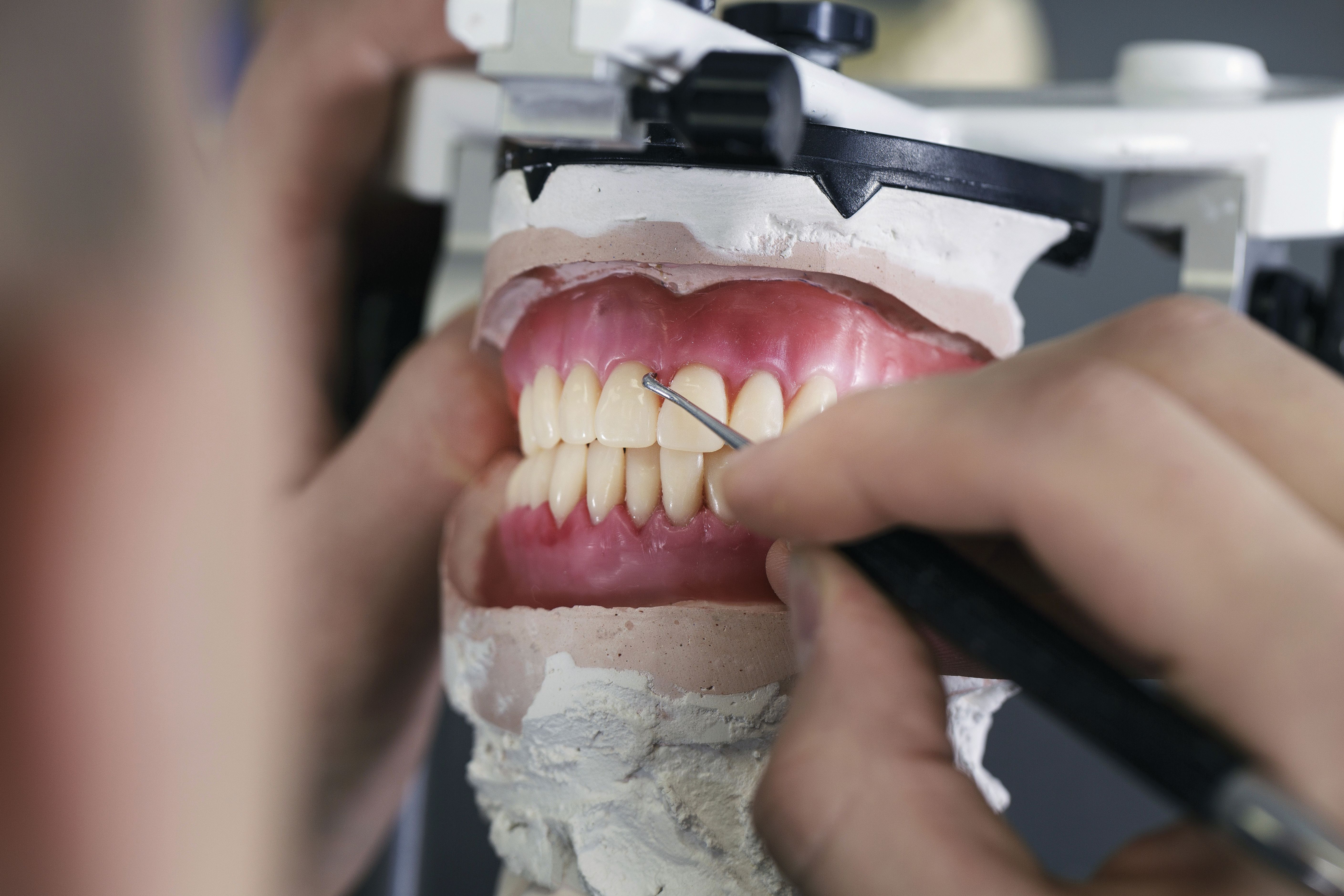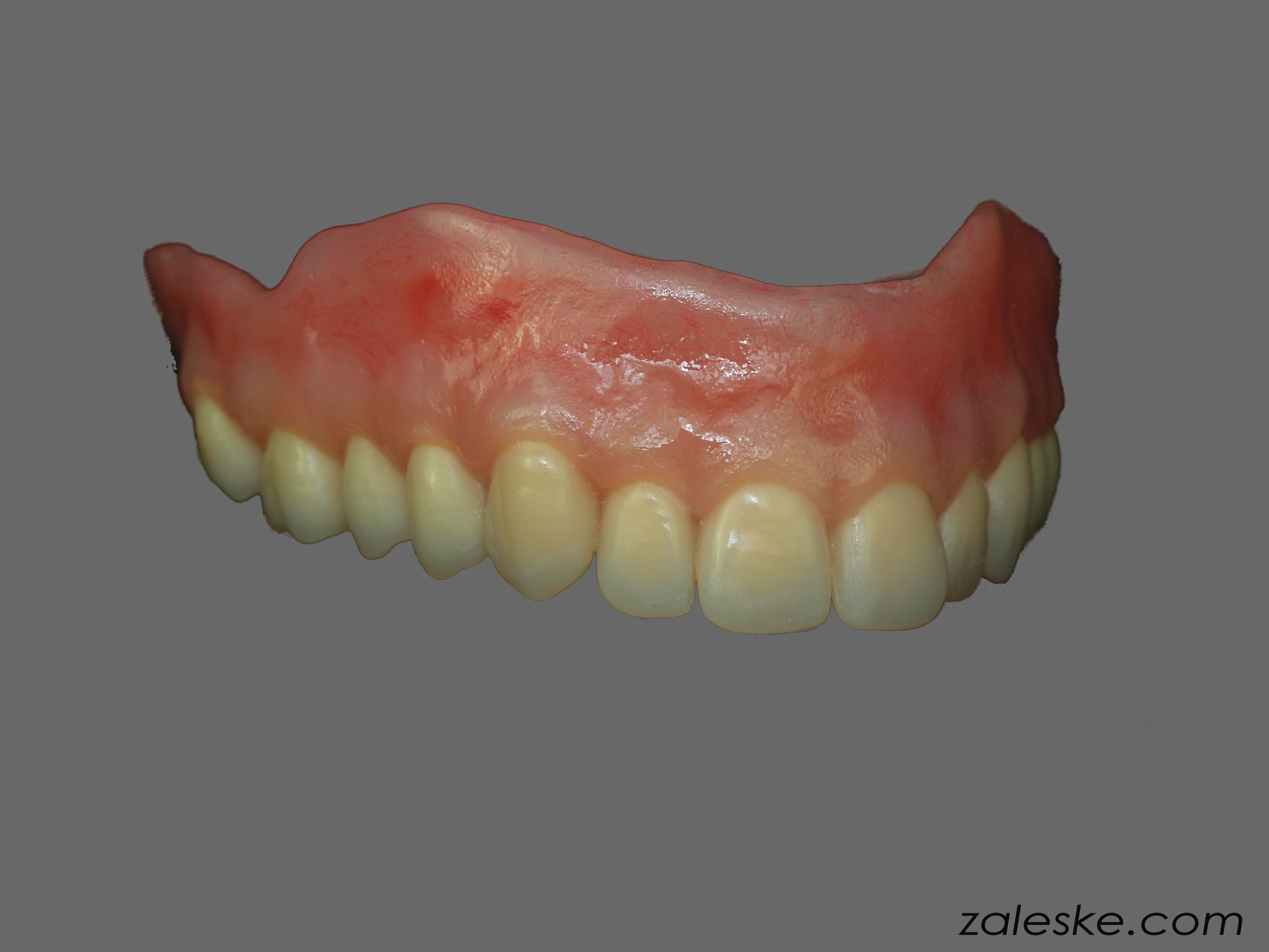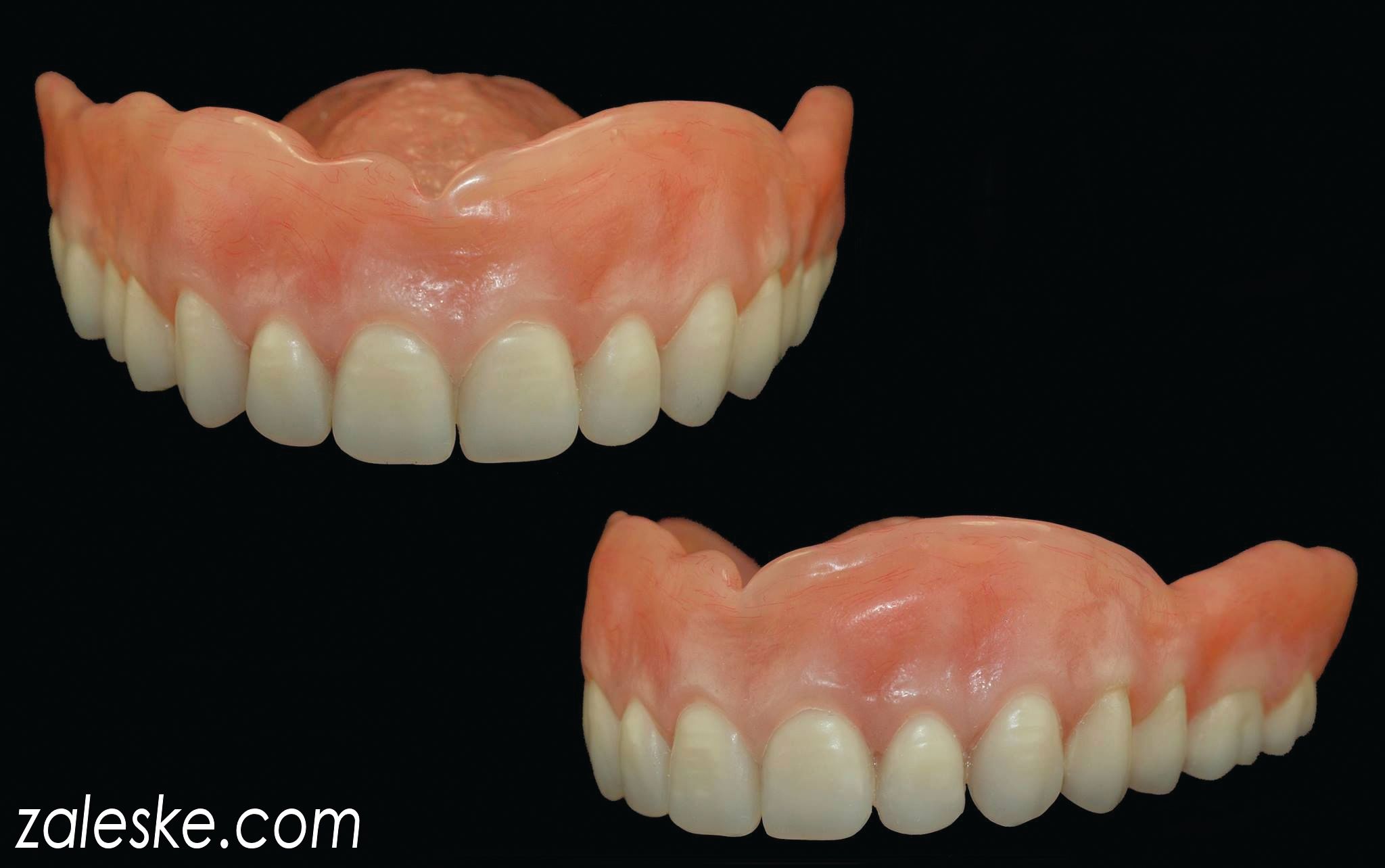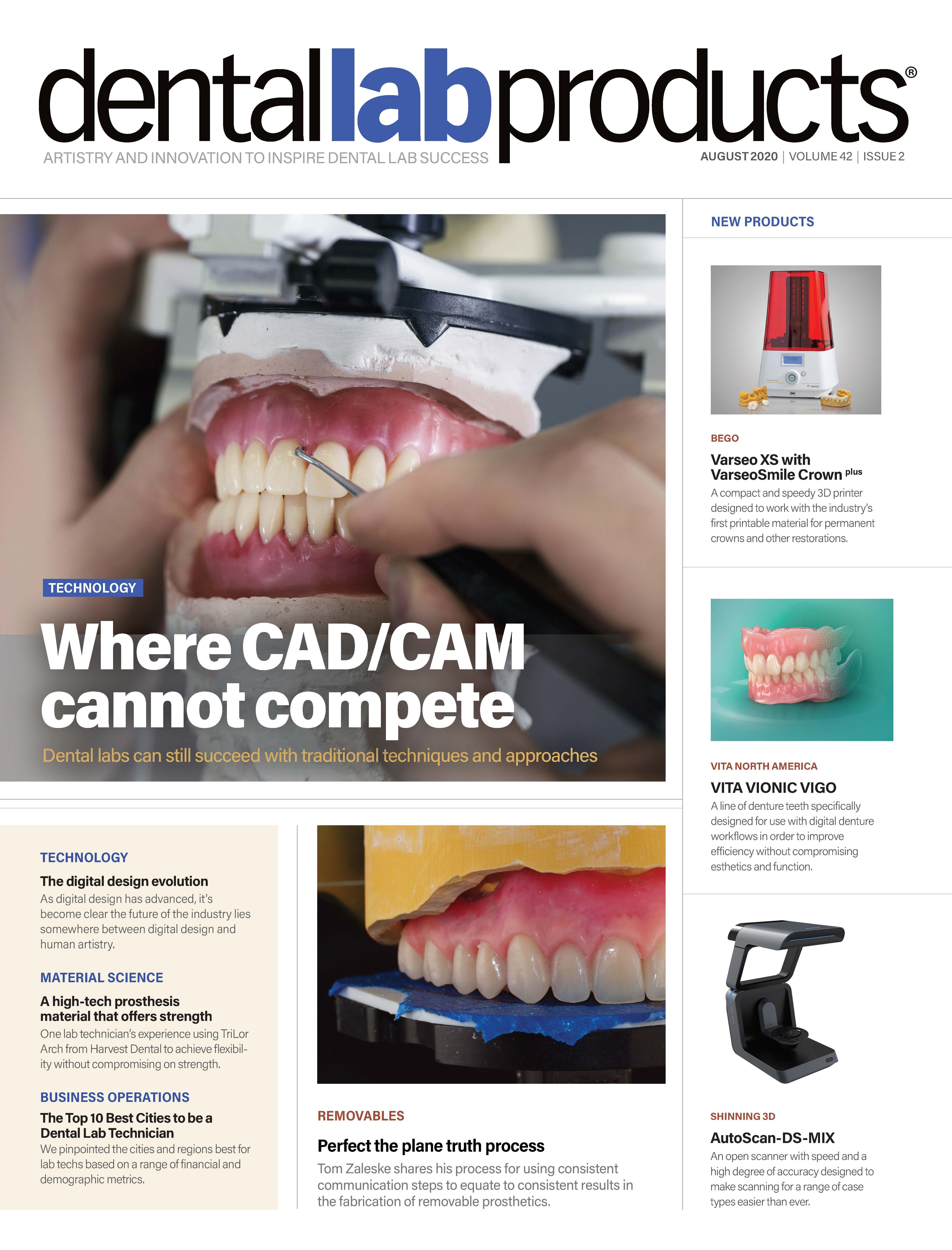Where CAD/CAM cannot compete
Dental labs can still succeed with traditional techniques and approaches.

Since the late 18th century, London’s Savile Row has been home to the world’s most exclusive bespoke tailors. A single custom-fit, hand-stitched suit can cost thousands of dollars, taking up to 12 weeks to deliver. Conversely, an individual can go to a department store and get something off the rack for a couple of hundred dollars. It’s a lot of money to spend on a suit, but buying something that’s handcrafted rather than mass-produced adds a certain element of attention to detail and élan.
A similar comparison exists between traditional, handmade restorations and CAD/CAM restorations that are gaining in popularity and prevalence. That is not to suggest, however, that one type of restoration is better than the other. Each has its merits and benefits, but for all the attention that CAD/CAM receives, labs shouldn’t forget the distinctions of analog restorations.
Attention to Detail
Like Savile Row’s suits, analog restorations are delivered thanks to the skilled eyes and hands of craftspeople. “For me it’s signature,” says Sasha Der Avanessian, founder and CEO of Harvest Dental Products in Berea, California. “People are going to differentiate themselves with their signature and [by spending] more time on esthetics, more time on the things that actually separate you, the things that move you into a different light. I’m a big believer in allowing yourself to spend more time on things that actually separate you in your work.”
Analog restorations also give technicians the opportunity to demonstrate their knowledge of form and function, Der Avanessian says. “From a theory standpoint, analog is important because it teaches us the theories of function and occlusion,” he notes. “And from a training standpoint, there still needs to be a real focus on analog for that knowledge of form and function.”
The human eye, with its attention to detail, can ferret out the subtleties that a computer might miss. “I see a situation, and I can go back to the doctor,” says Tom Zaleske, owner of Matrix Dental Laboratory and Consulting in Crown Point, Indiana. “I alert them to that situation. I can help steer the case. In other words, dental technicians with a knowledge base can provide oversight. We’re the technical resource for the doctor. What can and can’t we do? What do I see once I get the impression poured up? It could be a dozen different questions.”
Technicians training with a mouse or a stylus on a CAD/CAM design system, for instance, might not know what to look for, Zaleske says. They’re trained to move the mouse to a certain position based on a ridge, whereas hand-skilled technicians see what others miss, he adds.
Because CAD/CAM is so efficient and reproducible, practices expect more output from technicians with the required skill set. As a result, CAD/CAM technicians simply don’t have the resources to spend with each case. Zaleske observes, “If a guy is sitting at a machine and he’s running the mouse or pen and designing stuff, he hasn’t got time. He’s got to get them out the door. It turns into a widget. It becomes commoditized. So, with commoditization, like the guy at the coat hanger factory, he isn’t saying, ‘Hey, that loop doesn’t look right,’ because there are about 10,000 of those cranked out every hour.”
Dental technicians can provide oversight, and human interaction provides a layer of quality control that a computer can’t offer.

Human interaction, however, provides a layer of quality control that the computer can’t achieve. The analog technique allows technicians to add a finishing touch to the shape, says Richard Wills, owner of Duece Dental in Wichita Falls, Texas.
“I can sit there and tweak it a little bit,” Wills says. “I can look at the computer screen and get shapes figured out, but you’ve still got to put your hands on it and give it just a little finishing touch…a little bit of tweaking to get the shape that you just couldn’t see in that picture.”
Not every restoration requires grueling attention to detail. However, those that do, benefit from the human eye, especially when esthetics are critical. A hands-on approach adds a refinement that is hard to achieve digitally, Wills says. “The ones that look really nice, that’s where the analog comes in—putting your hands on it to give it that finesse. And I’m sure there are people out there who say they can get that done digitally, but I’m sure they still put their hands on it before they send it out the door,” he adds.
One of CAD/CAM’s pros is also one of its cons. Its comprehensive tooth design library files, though they provide the tooth shapes that labs need, end up lacking personality. The result is technicians use the same files to print similar-looking crowns, Zaleske says. “It’s going to be the same way with dentures. Everybody’s going to use the same files; everything’s going to start looking the same,” he notes.
This also poses a business quandary for the lab: If all patients’ restorations look the same, how does the lab differentiate itself?
“How do you stand apart?” Zaleske asks. “Will you stand apart from everybody else because you have to charge less? I’ve heard all the stories: ‘Oh yeah, you’ve got to service the account.’ OK, get past servicing the account, get past everything else. It comes down to price then, because there is no individuality. They all look the same.”
Skill
Most of the form and function benefits that the analog workflow afford are, quite simply, due to the training and skill of the lab technician. For instance, training and proficiency pay off when it comes to lighting, according to Dane Barlow, owner of Smiles by Dane in Boise, Idaho.
“I’ve had designers send me cases, and they couldn’t see that the light source was causing a certain shadowing, making them think that it was pointing a certain way,” Barlow says. This is similar to a dentist sitting on one side of the patient, with the teeth all facing in one direction, he adds. The teeth are parallel across the mouth and lean toward the side that the dentist is working on.
“As a technician, we have to understand these things,” Barlow continues. “And how many years did analog technicians sit in a corner with a light coming through a window on one side and carve their wax incorrectly? I’ve had technicians do that, and I had to move them to a different part of the room. ‘OK, here’s your new station. This is where you’re going to work from now on because the lighting is directly overhead or directly from the window.’ So, they would be able to see an equal shadow on each side. That same problem exists in software. And if they don’t know to look for it, if my world has been arches from the beginning and not single tooth, they don’t understand the cosmetics and the balance of it.”
Spartan Dental Lab in Lansing, Michigan, has been part of David Turpin’s family for four generations, more than 60 years. Digital wasn’t an immediate adoption for the lab, but when it was added, it underscored the place of analog workflows. That is, digital works for some things, but analog still delivers, especially when a technician’s skilled eye and hand are needed.
“My dad and I, we butted heads for a little while about whether it’s more efficient, and it is more efficient because we can cut out steps,” Turpin says. “But analog has its benefits because it’s a little easier to put the art back into it. Digital kind of commoditizes the industry a bit. People liked my grandfather, who took over from his father, and they came to him because of his artistry. Now it’s a little more commoditized. With digital, we’re losing that touch a little bit.”
A deeper connection exists between technicians in the analog world, who are craftspeople at heart, and their creations, Der Avanessian says. For analog technicians, the digitized process is less intimate and pulls them away from the creativity they bring to a traditional technique, he notes.
“It’s self-actualization of the dental technician,” Der Avanessian says. “The areas of creativity and esthetics and art—those were the areas that dental technicians really took a lot of pride in. You never really heard a lot about, ‘Look at how good this substructure was made.’ You need to have the function of a substructure. It needs to be designed with integrity, with minimum thicknesses…But at the end of the day, I think that opportunities to connect dental technicians back to loving what they do [center on] the touch, feel, and, sculpt elements of dental technology.”
Regrettably, sometimes that lack of skill or attention to detail is lost on patients and dentists. Patients have never experienced the difference, and dentists with limited educational or practice exposure have preconceived notions about prosthetics, Zaleske says. For him, crafting dental prosthetics is a necessity, and they are not analogous to handmade suits.
“This isn’t an elective thing that we do,” Zaleske says. “Suits are an elective thing. If you decide that you want a better suit, something that looks nicer, that fits better, you have to decide whether to buy it off the rack or pay thousands of dollars to have one custom-made. But at its core, we make a custom dental prosthetic for somebody who has lost their teeth to disease or an accident. It’s just like somebody who would make a facial prosthetic.”
Costs
In any business, costs matter, and whether analog or digital is more expensive depends on the lab and how it works. “Some processes, like the digital dentures, don’t cost less,” Turpin says. “I think it’s more of a wash in the cost of materials, but the machines are very expensive. So, I think that even on the material costs, it’s more the amount of labor that you save doing it.”
Materials for digital cost less compared with analog, but the equipment that uses the material is not cheap, Wills adds. He spends more on labor for analog than for digital, so his lab is saving on the number of individuals it needs to hire, he says. “With analog, you don’t have the equipment expense; you’ve just got manpower,” he observes.
CAD/CAM machines are just that—machines. They can be expensive and eventually become obsolete. Zaleske compares this to the music industry, which has moved from records to 8-tracks to cassettes to CDs and now, digital downloads. Eventually, one technology is phased out in favor of something shiny and new.
“[When] you buy a piece of equipment like that, you have an investment,” Zaleske says. “It’s a capital equipment investment, and it has a certain shelf life. It’s like everything. Well, that equipment has a shelf life. It’s only going to manufacture for you for so long before the next latest and greatest thing comes along because that’s the modus operandi of manufacturing. You trickle it out. You get a bunch of people invested in the technology, and then you milk them along. After 3 years, if the machine hasn’t paid for itself, you’re looking for a lease on a new machine.”
Labs should not base their value entirely on price but also on behaviors that make them more valuable than what they do, Der Avanessian suggests. He recommends innovating behavior to make a lab unique. At the end of the day, competition only exists where a lab’s value does not, he says.
“We hear about the race to the bottom a lot,” Der Avanessian says. “And to me, the race to the bottom is a territory. And the people who engage in that race are people who have not created a value proposition more valuable than their crown, which then makes price their only differentiator. I believe that you can be a profitable laboratory, whether you are milling your crown or not. The hard truth is that the market does not need another crown; it needs you. Your thumbprint tells you that you have no competitor. Act on that.”
Speed
It may seem counterintuitive, but in some cases, doing the work by hand can be faster than following a digital process. That is often the case when using a new design system. Digital tends to be a very slow process when a technician is getting started, Barlow says, and the transition isn’t necessarily easy.
For example, if a lab spends $3,000 on a computer that’s well designed for nesting, it would absolutely perform calculations faster. However, if the computer calculates through 80 or 90 percent when trying to set arches and it fails, a redesign may be necessary, Barlow says. And it can fail multiple times before the technician understands whether the issue lies with the nesting software or the design software.
“On the back end, once you start to understand what it’s doing wrong, you avoid that early on in your design completely,” Barlow says. “That’s something not every designer understands either. You have [one] person [doing] the nesting and [another] doing design. And if they’re not in great communication, the designer doesn’t know what he’s supposed to do to help the nesting software, and the guy who is providing the nesting has a hand in getting those designs to work. So, it does take a lot of communication and active learning to actually get the results that you want, which is efficiency and how things move correctly.”
Like all new technology, CAD/CAM machines can become obsolete and phased out.

Labs can regularly update CAD systems’ software with new functions and features, which is a plus. However, this can also become an unexpected obstacle for designers as options are changed out and don’t function as planned, Barlow says. Even if the technician and lab are producing digital products, they need a foundation in the functionality of the analog world.
“Everything we do digitally, if you have not done analog, you have no business doing it digitally,” Barlow says. “I just added a technician, walked up, and looked at the screen and said, ‘OK, well, how did you determine your orientation on a screen?’ ‘Well, I just said OK to that.’ ‘So that means you looked at the model work that’s on-screen and just arbitrarily determined that the face looks a certain way?’ ‘If you were doing this analog and had articulated it in the articulator, what would you do?’ [The tech said] ‘I would print out the photo of the patient with a grid or a retracted view. I would then orient what I’m looking at in the articulator.’ I said, ‘Great, so why haven’t you done that digitally, set a new custom view? Why did you just arbitrarily make it look like the stone arch is perfect?’”
Quality control for digital cases necessitates a need for a knowledge of function, the kind of knowledge that comes from having worked in the analog world. Even if a technician does send out a wrong case, the ceramist would ideally catch the mistake, usually by using analog and verifying with a photograph to make sure it’s articulated correctly, Barlow says.
“It really does require that people are following analog procedures, even in a digital space. There are lot of fun things to look at in software, but if they’re not working correctly yet, then it’s best to avoid them and not suffer the consequences or additional loss. It takes great technicians who understand analog to still teach and do their job in a digital workspace,” Barlow says.
Education
Although the appeal of digital includes speed, efficiency, and consistency, some would argue that an understanding of anatomy and of function gets lost in the workflow. It’s the sort of foundation learned in a formal setting. However, dental labs are struggling to find new technicians, according to Turpin.
“I know from talking to a lot of other labs that the problem with not going digital is the lack of technicians out there,” Turpin says. “It takes quite a bit of time to train them. Either you can find a great analog technician who is not very good with computers, or you can find someone who’s really great with computers, but they’re not a technician. There are only 13 schools in the country and, according to the NADL [National Association of Dental Laboratories] at a meeting I was at a few months ago, there were about 300 graduates in 2018. There are just shy of 6,000 dental labs in the United States, so not a lot are finding technicians. It’s harder to scale from a business aspect.”
As cases get more complex, the need for that education becomes even more apparent. There is a lack of formal education in the field, Zaleske says. Compounding that problem are individuals outsourcing and using offshore products from countries such as China, he explains.
Materials for digital cost less compared to analog materials, but the equipment that uses the material is often expensive.

“Because of that reason, labs had to find a way to compete. First off, owners, if you have a larger laboratory, you’ve got to find technicians,” Zaleske says. “Well, if there are no technicians around, you have to either create them in-house or look outside for another source to do that. It’s very distasteful for many people to use outsourcing. They’d like to keep it domestic. Labs have to look at how we can compete with China basically. What happened was that some of our larger laboratory groups and independent laboratories looked around and said, ‘Well, we don’t have enough people. We’re competing against China. We’ve got to bring in some sort of automation. We’ve got to find a way to fill those positions that would ordinarily be filled with human beings.’”
But that doesn’t mean that labs need to pick sides; a place exists for both analog and digital workflows. No lab can survive in a digital-only space or an analog-only space; labs need both to get by, and Der Avanessian believes the industry needs to define a middle ground.
“I think there’s really an opportunity for growth in both areas,” Der Avanessian says. “But I think we’ve kind of drawn a line right down the middle of our industry, and we’ve pushed digital to the left and analog to the right. My question is: What do we call the middle? Because the middle is actually where we live.”
As for form and function, digital allows technicians to automate the areas that they don’t compete on, so they can spend more time on the things that make them unique, Der Avanessian says. “It comes back to that idea of signature—your signature esthetic and, most of all, the exclusive behavior you possess and deploy at every human touchpoint where your dentist interacts with your lab. This is ultimately what’s going to separate you,” he explains.
That signature is a source of pride for the analog craftsperson, Wills adds, because technicians put a lot of pride into their work. This is the biggest difference between analog and digital, he notes.
“I’m sure there are lots of people out there who will argue against me on that. But if you put your heart and soul into working with your hands and making something look beautiful, that goes a long way,” Wills says. “I think that the digital method is just out there. [It’s] the cash cow because you can crank out a lot of work and make a lot of money without really knowing more than how a crown should look on the computer and stain and glaze it.”
From a functional standpoint, the suits fashioned in Savile Row are, by and large, no different from the ones found on a department store rack. The same can be said of restorations crafted by hand or created digitally. However, each method has its own advantages. Handmade restorations offer an element of personalization, the same element of care and craftsmanship that goes into those bespoke suits.
Images courtesy of Matrix Dental Laboratory and Consulting.

Product Bites – January 19, 2024
January 19th 2024Product Bites makes sure you don't miss the next innovation for your practice. This week's Product Bites podcast features new launches from Adravision, Formlabs, Owandy Radiology, Henry Schein Orthodontics, Dental Creations, and Dental Blue Box. [5 Minutes]
Product Bites – December 22, 2023
December 22nd 2023The weekly new products podcast from Dental Products Report is back. With a quick look at all of the newest dental product launches, Product Bites makes sure you don't miss the next innovation for your practice. This week's Product Bites podcast features updated software from Medit. [2 Minutes]